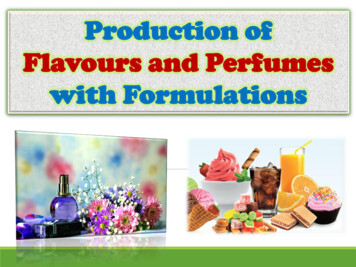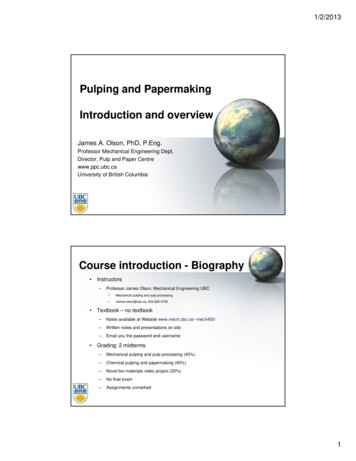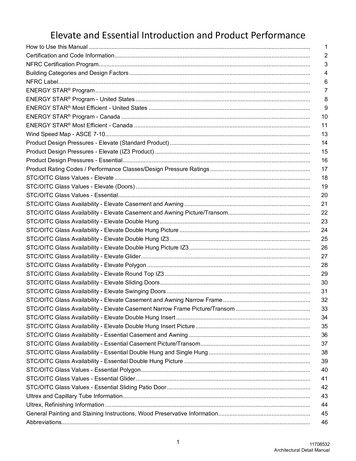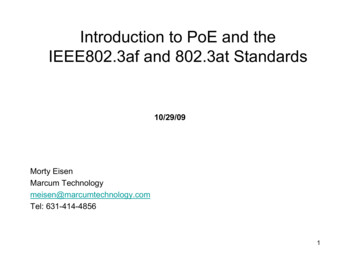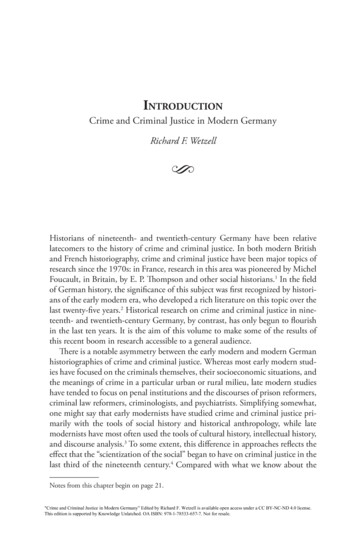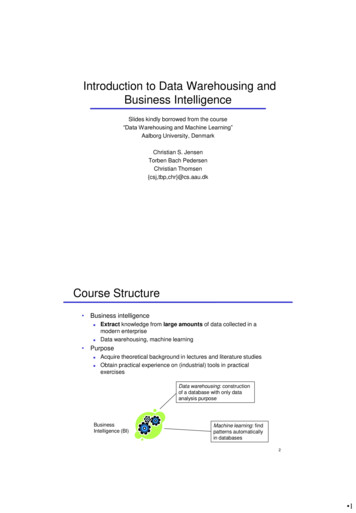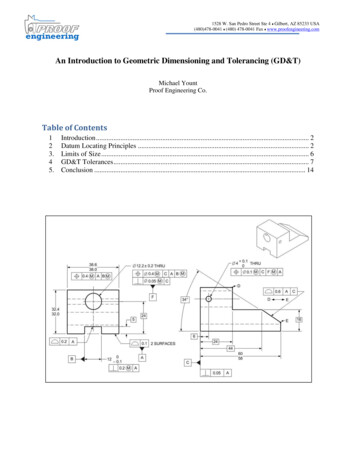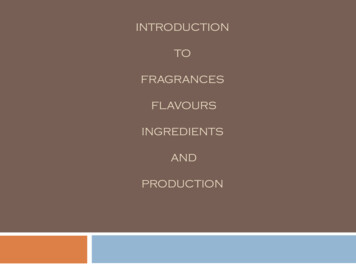
Transcription
UCTION
INTRODUCTION: Integral part of day to day life. Almost present inevery commodity. Fragrances used for external applications such asspray perfumes, body care, home care, cosmetics,soaps & detergents and incense. These are nonconsumables.
Flavours provide interesting taste & aroma toconsumables such as savouries, confectionaries, dairyproducts, beverages, etc. Dosage of fragrance & flavours limited to not morethan 1% for most products. Dosages of fragrances can be as high as 10% in caseof fine fragrances (spray perfumes) and incense(agarbatties).
Flavour & Fragrance, a judicious combination ofvarious odoriferous or aroma providing substances. Perfumers & Flavorists combine their art andknowledge of science (of the ingredients used). Standards set for quality ingredients by recognizedinternational institutions. Flavours & Fragrances produced in accordance withinternational regulations.
TYPES OF ACCORDS OR ODORSWoodyAmberAnimalicFloralCitrusGreen
TYPES OF ACCORDS OR ODORSFruitySpicePowderyOceanicMuskyFresh Mint
TYPES OF FLAVOURSVanillaFruityNuttySpicyMinty
The accords & aromas are provided by combination ofnatural extracts, essential oils, isolates, certain syntheticor semi-synthetic ingredients.Ingredients used by Flavorists & Perfumers can bebroadly placed in 2 categories viz.; Natural Ingredients. Synthetic / Semi Synthetic Ingredients. Ingredients synthetically made are also present in naturallyoccurring materials.
B. Natural ingredientsIsolates obtained in pure / concentrated forms fromPlantsFruitsHerbsTwigsSeedsStemsGumsRoots
Process of obtaining natural isolates is mostly physical wherethe aroma bearing herbage is subjected to; Steam / Hydro Distillation Solvent Extraction Super Critical Extraction
DEG - BHABKA SYSTEM
a. Steam / Hydro Distillation Process of obtaining essential oil at temp. ranging from 100to 110 deg.C. Plant material disintegrated and loaded in the distillationstill on a perforated plate. Dry saturated steam passed below the perforated plate. Travel of essential oil along with the steam in vapour formexiting from the still. Mixture of steam & vapour passing through the condensorresulting condensation. Condensate collected in an oil separator allowingseparation of water & oil.
Steam / Hydro Distillation Depending upon the density of oil, decantation is carriedout from the bottom or top of the separator. Filtration and removal of moisture from the oil by usingdehydrating agent. Oil sent for quality control. Wastage herbage burnt as fuel in the boiler for steamgeneration thus economizing the cost. Certain herbage dried and preserved for derivingOleoresin. Isolation of Oleoresin from herbage by Solvent / SuperCritical extraction or Chromatographic Separation.
a. Steam / Hydro Distillation
a. Steam / Hydro Distillation
B. Solvent extraction Process to isolate essential oil along with oleoresin presentin the plant material . Penetration of suitable solvent through the cells facilitatingsoluble material in solvent phase known as ‘Miscella’. Miscella decanted out from the herbage bed through filter. Isolation of solvent from Miscella by distillation in a SolventRecovery unit. Solvent condensed, rectified and stored for the next batch. Residual solvent freed from residue at moderate temp.,reduced pressure and at elongated time. Residue obtained is the Oleoresin, a viscous mass at roomtemperature.
B. Solvent extraction Removal of Oleoresin in the form of paste after cooling orwithdrawn warm as an oily mass later offered to perfumers& flavourists. In case of flowers, oleoresin obtained is known as‘Concrete’.
b. SOLVENT EXTRACTION
b. SOLVENT EXTRACTION (PILOT SCALE)
b. SOLVENT EXTRACTION (COMMERCIAL SCALE)
C. Super critical extraction Product produced almost natural. No damage caused to the product due to heat, no residualsolvents. Herbage brought in contact with Carbon Dioxide gas athigh pressure. Gas in this case is the solvent penetrating the cellsfacilitating out the oleoresin embedded in the plantmaterial. Extract obtained isolated from the plant material. Total escape of gas from the extract once brought atatmospheric pressure. Extract obtained truly natural, gas recycled for next batch.
C. Super critical extraction Equipment is capital intensive and is exorbitantly priced. Batch size seldom more than a few 100 kilos. Perfumers seldom use concretes in formulation owing towaxes present in them. Congealing process for removal of waxes from theconcretes by its dispersion in alcohol. Cold mass filtered and freed from the waxes. Isolation of alcohol from the extract by distillation in a ThinFilm Evaporator. Product free from alcohol called as ‘Absolute’ offered toperfumers.
C. Super critical extraction
PURIFICATION AND SEPARATION OF INGREDIENTS FROMNATURAL ESSENTIAL OIL BY FRACTIONAL DISTILLATIONFRACTIONATION” A TECHNIQUE TO SEPARATE THE RIGHT QUALITY & QUANTITY OFTHE COMPONENTS FROM THE ORGANIC MIXTURE. BY-A- MOLECULAR DISTILLATION UNITB - FRACTIONAL DISTILLATION UNIT
MOLECULLAR DISTILLATION UNIT For separating the volatile from non volatiles at highvacuum, low pressure and low temperature. The separation is important to safeguard and maintainedthe vital properties of the product. For refining the crude essential oils, oleoresins andresinoids. The oil can be dehydrated and decolorized withoutdisturbing the basic characteristics of the product.
MOLECULAR DISTILLATION UNIT STAGE - 1
MOLECULAR DISTILLATION UNIT STAGE - 2
MOLECULAR DISTILLATION UNIT
FRACTIONATING COLUMN
FRACTIONATING COLUMN
a. Synthetic ingredients Aroma chemicals having characteristic odors as permolecular structures. Produced by reaction of two or more synthetic or naturallyoccurring chemicals under specific temperatures andpressure conditions. Use of catalyst is done to bring about reactivity betweenthe molecules. Unreacted material & by-products formed are separatedfrom the main product by various physical processes, thusgiving the main product in the pure form. Main product kept for maturation before being offered toa perfumer or flavorist.
Process Equipment for Synthetic / Semi synthetic AromaIngredients (Liquids). Reaction kettles with accessories. Wash vessels. Flash distillation units with accessories. Fractionating column. Product Maturation Tank. Solvent Storage Tanks & Transfer Pumps.
REACTION VESSEL WITH ACCESSORIES
REACTION VESSEL WITH ACCESSORIES
GLASS LINED REACTION VESSEL WITH ACCESSORIES
GLASS LINED REACTION VESSEL WITH ACCESSORIES
Process Equipment for Synthetic / Semi synthetic AromaIngredients (Solids or Powders). Solution making tanks with stirrers. Filter with Pumps. Crystallizer. Centrifuge. Solvent Recovery system. Dryers. Multi mill. Sifter. Double Cone / Octagonal blender are required.
SOLIDS REFINING PLANT
Utilities & Services: Steam Generator / Boiler.Cooling Tower.Water Circulation Pump.Chilling Plant.Vacuum Pump.Nitrogen Supply Station or PSA System.Electrical Systems.Instrumentation.Equipped Testing Laboratory.Effluent Treatment Plant.Water Reservoir & Pump.Fire Fighting equipment & Safety devices.Material Handling equipment.
CONCLUSION Availability of various raw materials, both natural &synthetic. Skilled man power required for production. Economic viability depends on scale of operation andprocurement of raw material. Products produced with rigid quality control and offered atcompetitive prices prevail with good demand.THANK YOU ALL.PRESENTED BY: MR. V.K.MAURYAPHARMAC ENGINEERS, MUMBAI.
INTRODUCTION: Integral part of day to day life. Almost present in every commodity. spray perfumes, body care, home care, cosmetics, soaps & detergents and incense.File Size: 1MBPage Count: 40
